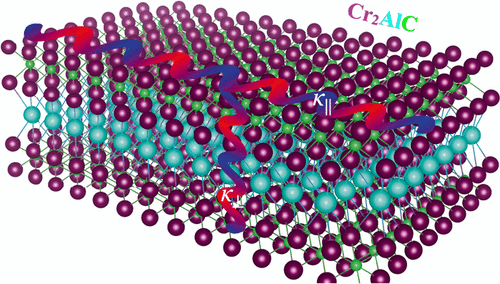当前位置:
X-MOL 学术
›
J. Phys. Chem. C
›
论文详情
Our official English website, www.x-mol.net, welcomes your feedback! (Note: you will need to create a separate account there.)
Heat Capacity and Anisotropic Thermal Conductivity in Cr2AlC Single Crystals at High Temperature
The Journal of Physical Chemistry C ( IF 3.7 ) Pub Date : 2020-10-19 , DOI: 10.1021/acs.jpcc.0c08384 A. Champagne 1 , J.-L. Battaglia 2 , T. Ouisse 3 , F. Ricci 1 , A. Kusiak 2 , C. Pradere 2 , V. Natu 4 , A. Dewandre 5 , M. J. Verstraete 5 , M. W. Barsoum 4 , J.-C. Charlier 1
The Journal of Physical Chemistry C ( IF 3.7 ) Pub Date : 2020-10-19 , DOI: 10.1021/acs.jpcc.0c08384 A. Champagne 1 , J.-L. Battaglia 2 , T. Ouisse 3 , F. Ricci 1 , A. Kusiak 2 , C. Pradere 2 , V. Natu 4 , A. Dewandre 5 , M. J. Verstraete 5 , M. W. Barsoum 4 , J.-C. Charlier 1
Affiliation

|
The temperature dependences of both heat capacity and thermal conductivity in nanolamellar Cr2AlC single crystals are measured using modulated photothermal radiometry and compared to first-principles calculations. The electronic contribution to the thermal conductivity of Cr2AlC single crystals is computed ab initio by determining the electronic transport coefficients using density functional theory and by solving the Bloch–Boltzmann transport equation with a temperature-dependent relaxation time. The lattice thermal conductivity is predicted by going beyond the quasi-harmonic approximation and considering renormalized second- and third-order force constant matrices, with anharmonic three-phonon scattering, isotopic scattering, and scattering by carbon vacancies. Isotopic scattering does not modify the lattice thermal conductivity. In contrast, even a small concentration of carbon vacancies induces a substantial decrease of the in-plane lattice thermal conductivity. The anisotropy measured in the thermal conductivity, with a ratio of ∼2 over the whole temperature range, is confirmed theoretically. This anisotropy seems to mainly arise from lattice contributions. A similar anisotropy is expected for other MAX phases with identical layered structures.
中文翻译:

高温下Cr 2 AlC单晶的热容和各向异性导热系数
纳米层状Cr 2 AlC单晶中热容量和热导率的温度依赖性是使用调制光热辐射法测量的,并与第一性原理计算进行了比较。从头计算电子对Cr 2 AlC单晶导热性的贡献通过使用密度泛函理论确定电子输运系数,并通过求解与温度相关的弛豫时间的布洛赫-玻尔兹曼输运方程。通过超越准谐近似,并考虑重新归一化的二阶和三阶力常数矩阵,非谐三声子散射,同位素散射和碳空位散射,可以预测晶格热导率。同位素散射不会改变晶格的热导率。相反,即使浓度很小的碳空位也会引起面内晶格热导率的大幅降低。理论上证实了在整个温度范围内,导热系数的各向异性约为2。这种各向异性似乎主要来自晶格贡献。对于具有相同分层结构的其他MAX相,预计会有类似的各向异性。
更新日期:2020-10-30
中文翻译:

高温下Cr 2 AlC单晶的热容和各向异性导热系数
纳米层状Cr 2 AlC单晶中热容量和热导率的温度依赖性是使用调制光热辐射法测量的,并与第一性原理计算进行了比较。从头计算电子对Cr 2 AlC单晶导热性的贡献通过使用密度泛函理论确定电子输运系数,并通过求解与温度相关的弛豫时间的布洛赫-玻尔兹曼输运方程。通过超越准谐近似,并考虑重新归一化的二阶和三阶力常数矩阵,非谐三声子散射,同位素散射和碳空位散射,可以预测晶格热导率。同位素散射不会改变晶格的热导率。相反,即使浓度很小的碳空位也会引起面内晶格热导率的大幅降低。理论上证实了在整个温度范围内,导热系数的各向异性约为2。这种各向异性似乎主要来自晶格贡献。对于具有相同分层结构的其他MAX相,预计会有类似的各向异性。



























 京公网安备 11010802027423号
京公网安备 11010802027423号